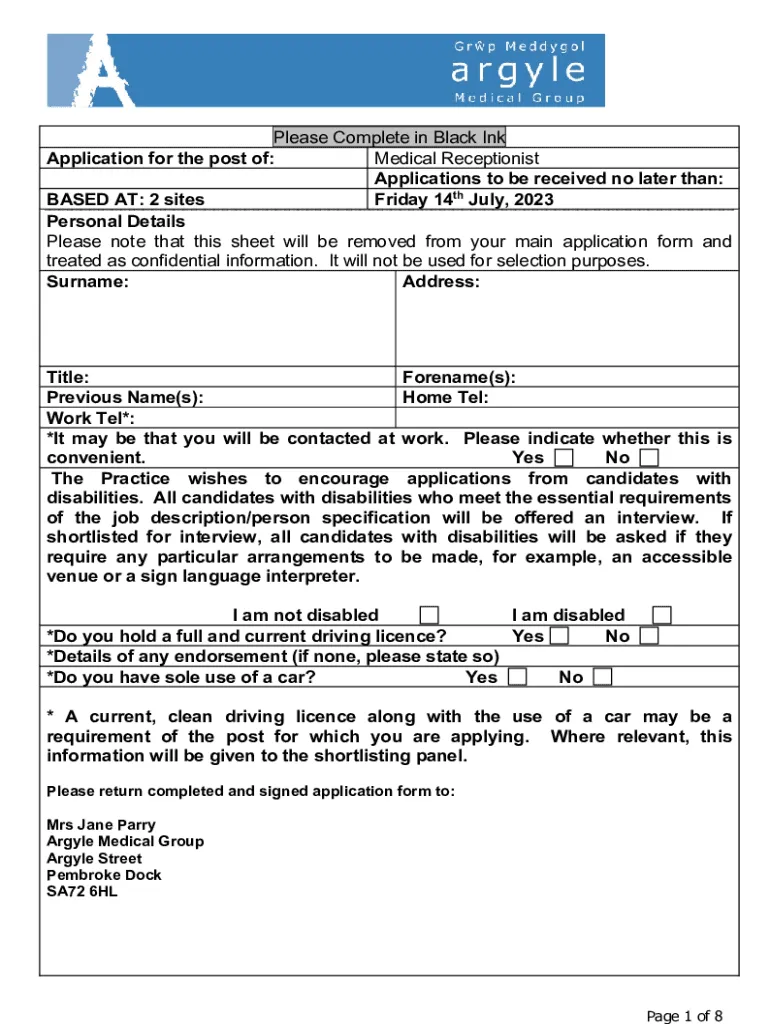Understanding the Importance of a Medical Receptionist Cover Letter
A well-crafted cover letter is a crucial first step in landing your dream job as a medical receptionist. It’s your initial introduction to the hiring manager and a chance to make a strong impression, even before they review your resume. The cover letter offers a space to showcase your personality, enthusiasm, and specific qualifications that align with the job description. It allows you to explain why you’re the perfect fit for the role, going beyond the basic details provided in your resume. Essentially, it’s your opportunity to highlight your unique skills and experiences and demonstrate your genuine interest in the position and the healthcare field. A compelling cover letter can set you apart from other applicants and significantly increase your chances of being invited for an interview. Furthermore, it shows your professionalism and attention to detail, qualities highly valued in a medical environment. A poorly written or generic cover letter, on the other hand, can quickly lead to your application being overlooked, so investing time and effort in this document is essential.
Key Components of a Strong Medical Receptionist Cover Letter
A strong cover letter should include several key components to effectively communicate your suitability for the medical receptionist position. These components work together to create a cohesive and compelling narrative about your qualifications and passion for the role. A professional cover letter typically begins with your contact information and the date, followed by the hiring manager’s contact details. A polite and formal salutation, addressing the hiring manager by name if possible, sets a positive tone. The opening paragraph should immediately grab the reader’s attention, expressing your interest and stating the specific position you’re applying for. The body of the letter should highlight relevant skills and experiences, demonstrating how your qualifications align with the job requirements. It’s important to showcase your communication, interpersonal, and administrative abilities. Provide specific examples of your achievements and quantify them whenever possible. The closing paragraph should reiterate your interest, express your gratitude for their time, and include a call to action, such as stating your availability for an interview. Finally, proofread and format your cover letter for clarity and professionalism.
Contact Information and Salutation
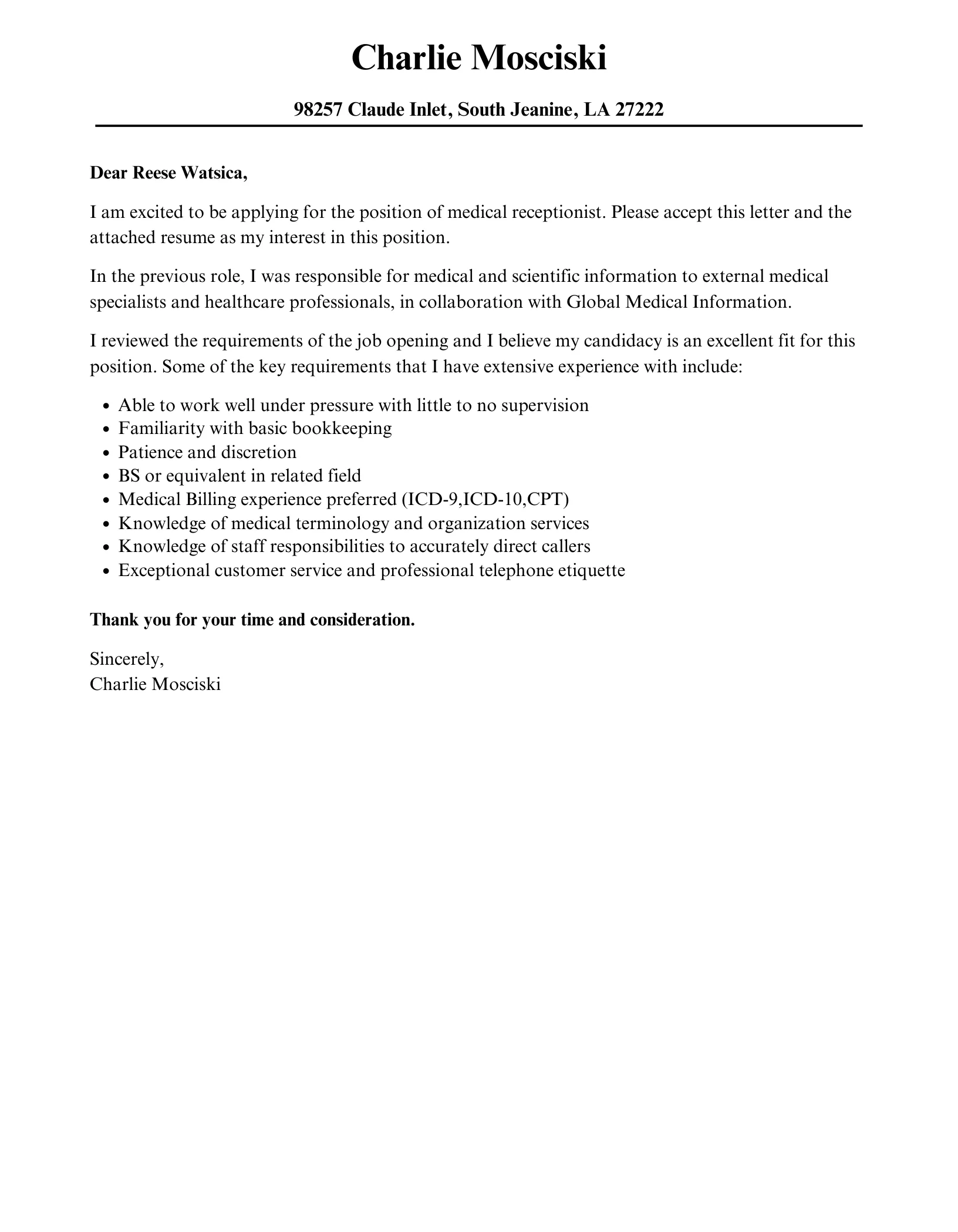
The beginning of your cover letter should include essential contact information to allow the hiring manager to easily reach you. Start with your full name, address, phone number, and professional email address at the top of the page. Ensure that your email address is professional and appropriate; avoid using nicknames or informal language. Following this, include the date of the letter and the hiring manager’s contact information, if available. If the name of the hiring manager is provided in the job posting, use it; otherwise, use a general salutation like “Dear Hiring Manager.” Using a specific name shows that you have taken the time to research the company and demonstrates your attention to detail. The salutation sets the tone for the rest of the letter, so make sure it is professional and respectful. Double-check all contact details for accuracy to avoid any miscommunication or missed opportunities. A well-formatted contact section immediately conveys your professionalism and helps the hiring manager easily reach out to you regarding your application.
Opening Paragraph Making a Great First Impression
The opening paragraph is your first and often only chance to capture the hiring manager’s attention, so it’s critical to make it count. Begin by clearly stating the specific medical receptionist position you are applying for and where you found the job posting. Express your genuine interest in the role and the healthcare facility. Immediately convey why you are interested in the position and highlight one or two of your most relevant skills or experiences that align with the job requirements. Keep the opening paragraph concise and to the point. Show enthusiasm and a clear understanding of what the role entails. Avoid generic phrases like “I am writing to express my interest.” Instead, craft a compelling opening that showcases your unique qualifications and makes the reader want to learn more. A strong opening paragraph sets the stage for the rest of your cover letter and compels the hiring manager to continue reading and consider your application.
Highlighting Relevant Skills and Experience
The main body of your cover letter should focus on highlighting the relevant skills and experiences that make you an ideal candidate for the medical receptionist position. Thoroughly review the job description and identify the key requirements and qualifications. Then, discuss how your previous experiences have equipped you with these skills. Provide specific examples of how you have demonstrated these skills in past roles, using the STAR method (Situation, Task, Action, Result) to describe your accomplishments. For example, if the job description requires strong communication skills, provide an example of a time you successfully managed a difficult patient or resolved a conflict. Focus on what you accomplished and what the outcome was. Emphasize any experience with medical software, appointment scheduling, insurance verification, and patient record management. Use action verbs to describe your accomplishments and showcase your abilities. Tailor your letter to each specific job posting to reflect the particular needs of the healthcare facility, ensuring that the hiring manager can easily see how your skills and experience align with their requirements. This makes the letter more relevant and increases your chances of getting noticed.
Communication and Interpersonal Skills
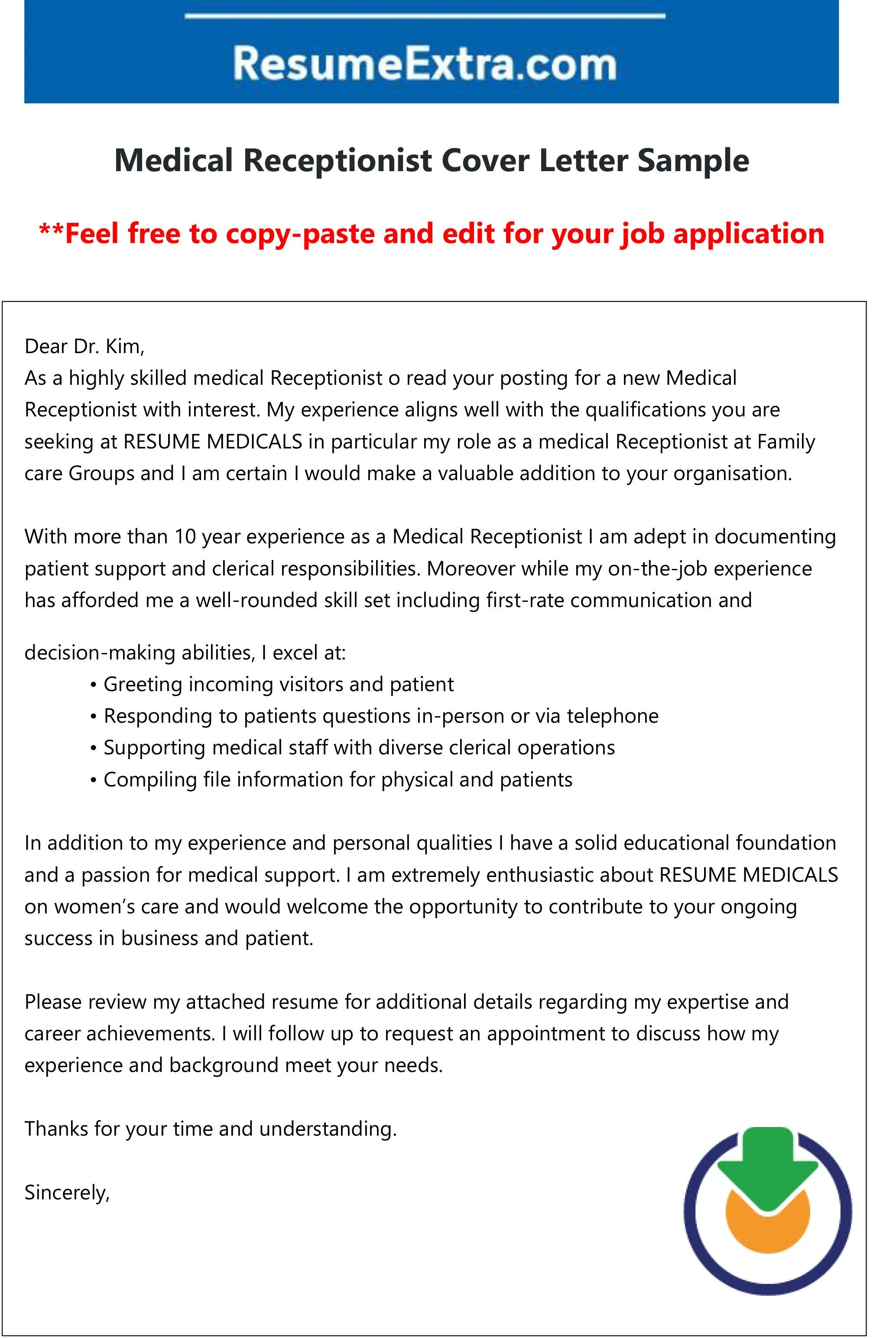
As a medical receptionist, excellent communication and interpersonal skills are paramount. These skills directly impact the patient experience and the overall efficiency of the medical practice. In your cover letter, highlight your ability to communicate effectively with patients, medical staff, and other stakeholders. Describe your active listening skills, empathy, and ability to convey information clearly and concisely, both verbally and in writing. Provide examples of situations where you have successfully communicated with patients, particularly when dealing with sensitive information or difficult situations. Discuss your ability to build rapport with patients and create a welcoming and supportive environment. Mention any experience you have in conflict resolution or dealing with patient complaints professionally. Emphasize your ability to maintain confidentiality and adhere to patient privacy regulations. Showcase your ability to work collaboratively with a team and contribute to a positive and productive work environment. Highlighting these skills showcases your ability to handle the core of the medical receptionist role, ensuring smooth patient interactions and an efficient office.
Administrative and Organizational Abilities
Administrative and organizational skills are essential for a medical receptionist to maintain an efficient and well-managed office. In your cover letter, showcase your ability to manage multiple tasks, prioritize responsibilities, and work in a fast-paced environment. Describe your experience with scheduling appointments, managing patient records, and handling phone calls. Provide examples of how you have successfully implemented organizational systems or improved office efficiency in previous roles. Highlight your proficiency in data entry, record keeping, and other administrative tasks. Mention your attention to detail and accuracy, especially when dealing with patient information, insurance verification, and financial transactions. Emphasize your experience with managing patient flow, ensuring smooth check-in and check-out processes, and coordinating with medical staff to provide excellent patient care. Demonstrate your ability to maintain confidentiality and adhere to HIPAA regulations. This section will give the hiring manager confidence that you can handle the administrative responsibilities of the role effectively, thus helping the practice run smoothly.
Technical Skills and Software Proficiency
Modern medical practices rely heavily on technology, making technical skills and software proficiency critical for a medical receptionist. In your cover letter, list the specific software and technologies you are proficient in. Mention any experience you have with electronic health records (EHR) systems, such as Epic, Cerner, or Practice Fusion. Detail your experience with medical billing software, appointment scheduling systems, and other relevant applications. Highlight your ability to use Microsoft Office Suite (Word, Excel, Outlook) and other office software. Describe your typing speed and accuracy, as well as your ability to learn new software quickly. If you have experience with insurance verification, coding, or other technical aspects of healthcare administration, be sure to mention them. Be specific about your level of proficiency with each technology. If you have completed any training or certifications related to these systems, include them. Demonstrating your technical skills shows the hiring manager that you can seamlessly integrate into the practice and contribute to its efficient operation.
Demonstrating Your Passion for Healthcare
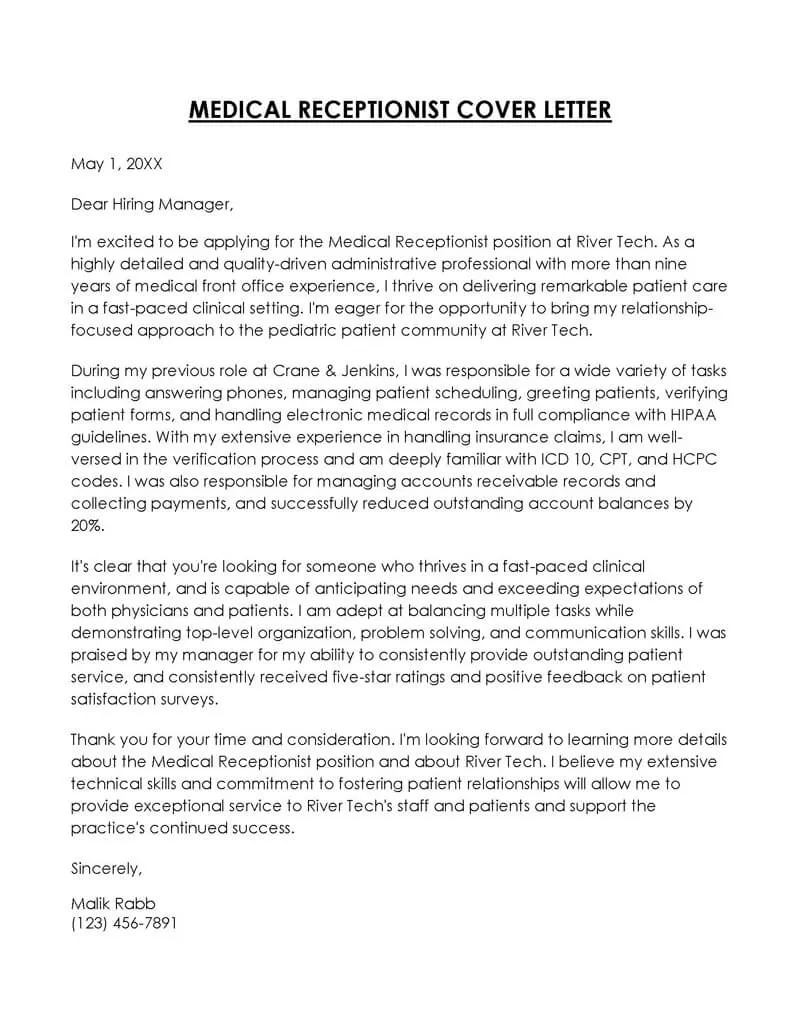
Expressing your passion for healthcare is crucial in your cover letter, as it shows your genuine interest and commitment to the field. Explain why you are drawn to the healthcare industry and what motivates you to work in a medical setting. Share your personal experiences or aspirations that have led you to pursue a career as a medical receptionist. Highlight any volunteer work or experiences you have in the healthcare field. If you are passionate about patient care, state it clearly, emphasizing your commitment to providing excellent service and creating a positive experience for patients. Mention your desire to contribute to a welcoming and supportive environment where patients feel comfortable and cared for. Showcase your understanding of the importance of empathy, compassion, and respect in patient interactions. Showcasing your passion helps the hiring manager understand your commitment and ensures you will bring a genuine interest and dedication to the role. By demonstrating your enthusiasm for the healthcare field, you showcase your potential to be a valued member of the team.
Quantifying Achievements to Showcase Value
Quantifying your achievements is a powerful way to demonstrate your value to a potential employer. Instead of simply stating your responsibilities, provide specific examples of what you accomplished in previous roles, using numbers and data to support your claims. When describing your experience, use metrics whenever possible. For example, instead of saying “Managed patient scheduling,” say “Scheduled an average of 50 appointments per day, ensuring a smooth patient flow.” If you improved office efficiency, quantify the impact by stating, “Reduced patient wait times by 15% through improved scheduling practices.” If you handled billing or insurance claims, mention the percentage of claims you successfully processed or the amount of money you saved the practice. Quantifying your achievements helps the hiring manager understand the tangible results you have produced in the past. Use these specific examples to illustrate your accomplishments, allowing the hiring manager to clearly understand your value.
Addressing the Employer’s Needs and Requirements
Tailoring your cover letter to the specific needs and requirements of the employer demonstrates that you have carefully considered the job description and are a good fit for the role. Carefully review the job posting and identify the key skills, experiences, and qualifications that the employer is seeking. Address each of these requirements in your cover letter, explaining how your skills and experiences align with their needs. Provide specific examples of how you have successfully demonstrated these skills in the past. Highlight any relevant experience with the specific software, technologies, or medical specialties mentioned in the job description. Use keywords from the job description throughout your cover letter. Demonstrate your understanding of the healthcare facility’s mission, values, and patient population. This may involve researching the facility online. This level of customization proves that you are not just sending out a generic cover letter and that you are genuinely interested in this particular opportunity.
Tailoring Your Cover Letter to the Specific Job
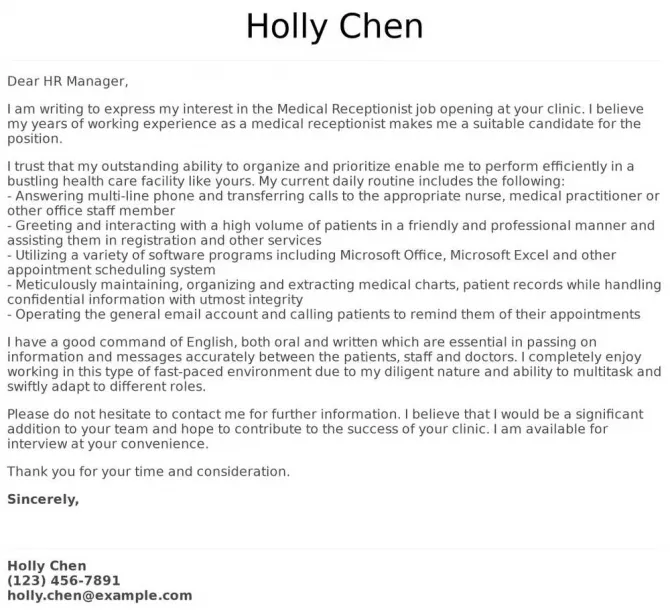
Customizing your cover letter to each job application is essential to make a strong impression and highlight the specific skills and experiences most relevant to the employer. Avoid using a generic template. Instead, carefully read the job description and tailor your cover letter to match the requirements and expectations outlined there. Identify the key skills and experiences the employer is seeking. Then, highlight the relevant aspects of your background, providing specific examples to show how you have successfully demonstrated those skills in the past. Research the healthcare facility or practice to understand their mission, values, and patient population. This will allow you to show how your skills and experience can contribute to their specific goals. Show genuine enthusiasm for the opportunity and a clear understanding of the role’s responsibilities. By demonstrating this level of attention to detail, you’ll significantly increase your chances of getting noticed by the hiring manager. Tailoring your cover letter to each job shows you are genuinely interested in the role and have the skills and experience needed to excel.
Closing Paragraph Call to Action
The closing paragraph of your cover letter should leave a lasting positive impression and encourage the hiring manager to take the next step. Reiterate your interest in the position and express your enthusiasm for the opportunity. Thank the hiring manager for their time and consideration. Clearly state your availability for an interview and how they can contact you. Make it easy for them to reach out by including your phone number and email address. Express your willingness to provide any additional information they may need. Consider adding a call to action that invites them to review your resume and contact you to discuss your qualifications further. Ensure the closing paragraph is professional and polite. End with a formal closing, such as “Sincerely” or “Thank you for your consideration,” followed by your name. A strong closing paragraph provides a clear sense of closure and encourages the hiring manager to move your application forward. A well-crafted call to action can significantly increase your chances of securing an interview.
Proofreading and Formatting Your Cover Letter
Before submitting your cover letter, it is essential to proofread and format it meticulously to ensure it presents a professional image. Proofreading is critical to catch any errors in grammar, spelling, and punctuation. These errors can detract from your message and create a negative impression. Read your cover letter multiple times, or better yet, have a friend or family member review it. Pay close attention to sentence structure, word choice, and clarity. Formatting also plays a significant role in the overall appearance of your cover letter. Use a professional and easy-to-read font, such as Times New Roman, Arial, or Calibri. Ensure the font size is appropriate (usually 11 or 12 points). Use clear and concise language, and avoid jargon or overly complex phrasing. Maintain consistent formatting throughout the document. Use paragraphs to break up the text and make it easier to read. Check for any inconsistencies in spacing, margins, or alignment. A well-formatted cover letter demonstrates attention to detail, showing your professionalism and ability to communicate clearly. Take the time to proofread and format your cover letter correctly before submitting it.
Common Mistakes to Avoid in Your Cover Letter
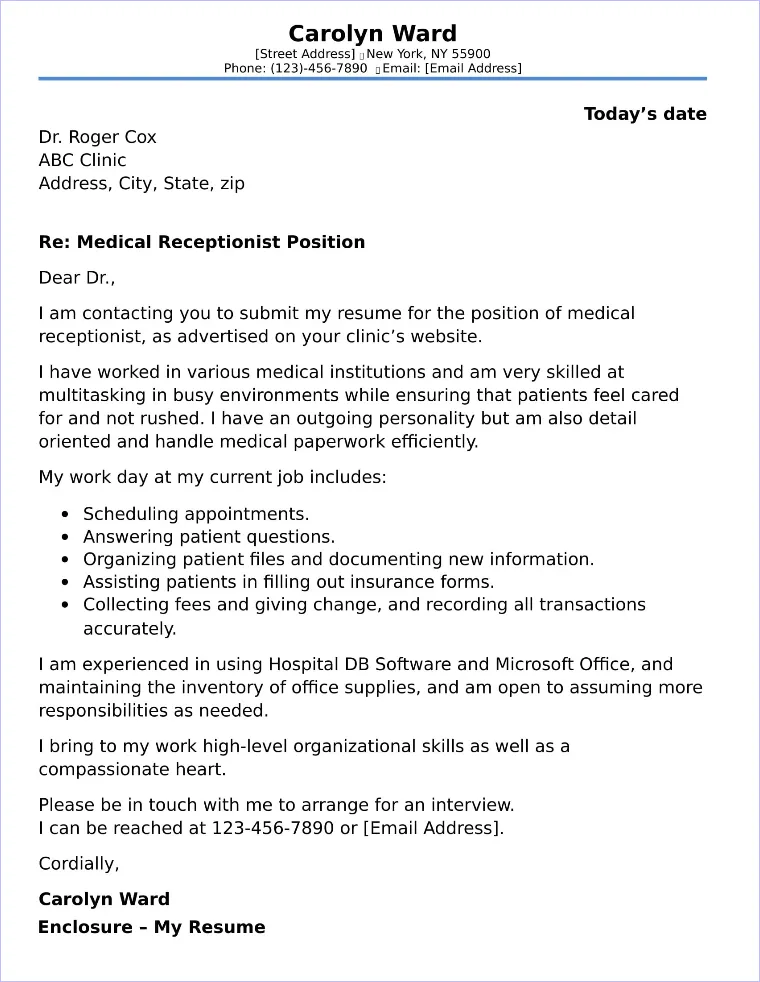
Avoiding common mistakes is crucial for creating a strong cover letter that effectively showcases your qualifications. One common mistake is sending a generic cover letter that doesn’t tailor to the specific job. Always customize your letter to the job requirements and the employer. Another mistake is making grammatical errors or typos. Proofread your cover letter carefully to ensure it is free of errors. Avoid using overly casual language or slang. Maintain a professional tone throughout the letter. Don’t be overly wordy or repetitive. Be concise and to the point, focusing on your most relevant skills and experiences. Avoid negative language or criticizing past employers. Focus on your strengths and accomplishments. Do not include irrelevant information. Stick to the skills and experiences that align with the job description. Never lie or exaggerate on your cover letter. Honesty is essential. Avoid simply restating your resume. Use the cover letter to elaborate on your skills and experiences, providing examples and context. By avoiding these common pitfalls, you can create a cover letter that makes a positive impression and significantly boosts your chances of landing an interview.
